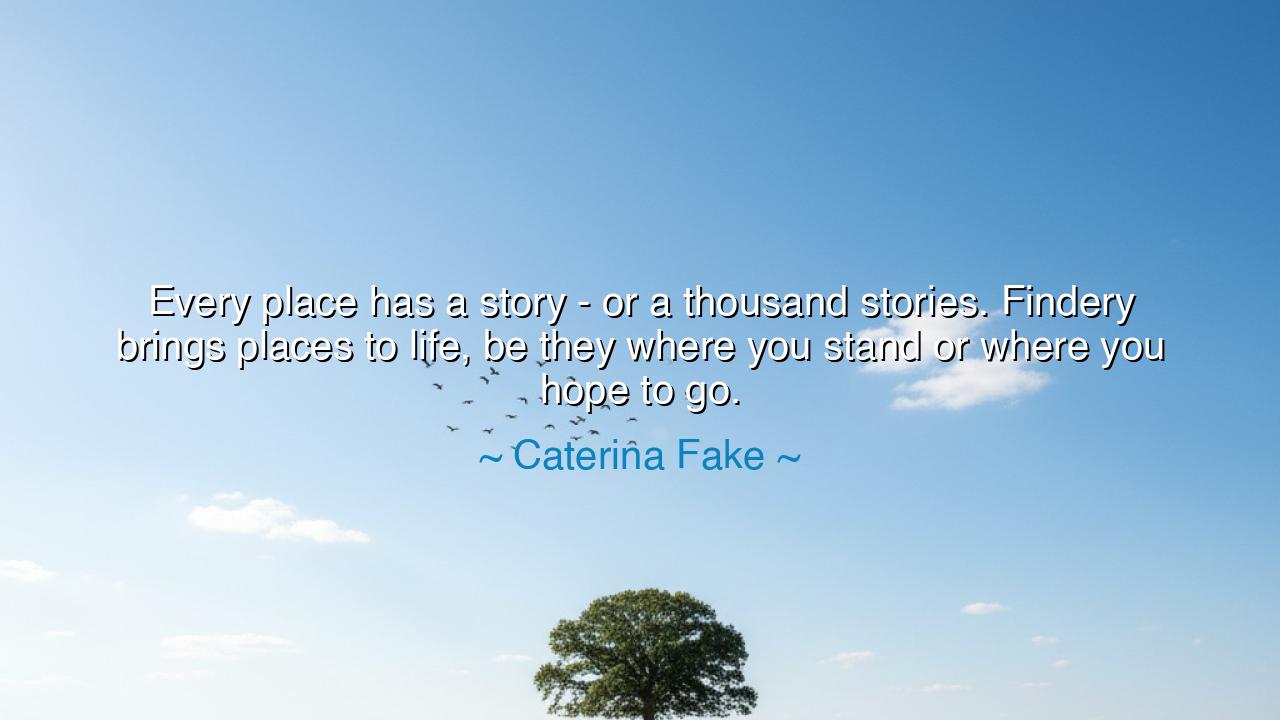
Every place has a story - or a thousand stories. Findery brings
Every place has a story - or a thousand stories. Findery brings places to life, be they where you stand or where you hope to go.






The words of Caterina Fake, "Every place has a story – or a thousand stories. Findery brings places to life, be they where you stand or where you hope to go," remind us of a sacred truth that has followed humankind since the dawn of memory: the earth remembers. Every street, every mountain, every silent corner where footsteps have faded holds the echo of human experience. It is not only the land that shapes us; we, too, shape the land through our dreams, our griefs, and our triumphs. The quote is born from Fake’s vision of Findery, a digital map of human memory—a modern way to weave the tapestry of place and story, where technology becomes a vessel for living history.
To say that every place has a story is to recognize that space and soul are intertwined. Long before words were written, the ancients carved meaning into stone and whispered legends into the wind. A grove became sacred because someone once prayed there; a hill became haunted because a tragedy took root in its shadow. When we walk through cities and countrysides today, we tread upon invisible worlds—stories untold, forgotten, or waiting to be rediscovered. To those who listen, the stones still speak, and the rivers still murmur the voices of the past.
Consider the city of Pompeii, once buried beneath the wrath of Mount Vesuvius. For centuries, it slept beneath ash, its people lost to time. Yet when it was unearthed, the city spoke again: frescoes bloomed on the walls, laughter echoed through taverns frozen mid-song, and human figures, caught in their final moments, reminded the world that even death cannot silence the story of a place. Pompeii’s ruins became not merely relics of a civilization but bearers of feeling—a testament that where humans have lived, meaning endures.
So too, Caterina Fake’s vision invites us to see our modern world not as cold geography but as a living atlas of emotion. With each note, each shared story, each digital pin placed upon a map, people reawaken the pulse of forgotten places. It is the same instinct that made travelers once carve their initials into ancient stones or poets describe sunsets over their hometowns. Through technology, we are returning to an ancient act—the ritual of remembrance—but with a new reach, a global voice.
This understanding carries a deeper call: to be present where you stand. Too often, we wander without seeing, passing through spaces as if they were mere backdrops to our lives. Yet every step we take is upon sacred ground—the footsteps of ancestors, the dreams of strangers, the silent witnesses of centuries. When we learn to look and to listen, even the simplest street corner becomes luminous with human spirit. To live this way is to live attuned to the world’s hidden narratives.
Let us also not forget that places are not only what they have been—but what they yearn to become. The phrase “where you hope to go” reminds us that imagination, too, writes geography. A traveler dreams of distant lands long before he arrives; a child looks upon a mountain and imagines its summit before taking the first step. The stories we project into the future are no less sacred than those preserved from the past. Thus, the map of the soul is ever expanding, marked by our hopes as much as our memories.
The lesson, then, is clear and profound: listen to the earth. Wherever you go, seek the unseen story. When you travel, do not merely photograph—ask who once stood where you now stand. When you return home, look upon your own city with new eyes, as if it were ancient and holy. Leave behind your own story, too—a trace for others to find. For when the next traveler passes, they will walk not only through space, but through your memory, your laughter, your love. And in that eternal exchange, the world comes to life again.
Thus, the quote of Caterina Fake becomes not only a reflection of her creation, but a philosophy of living: to see the world as a living library, to touch places not with haste but with reverence, and to contribute one’s own verse to the vast, ever-growing poem of existence.






AAdministratorAdministrator
Welcome, honored guests. Please leave a comment, we will respond soon